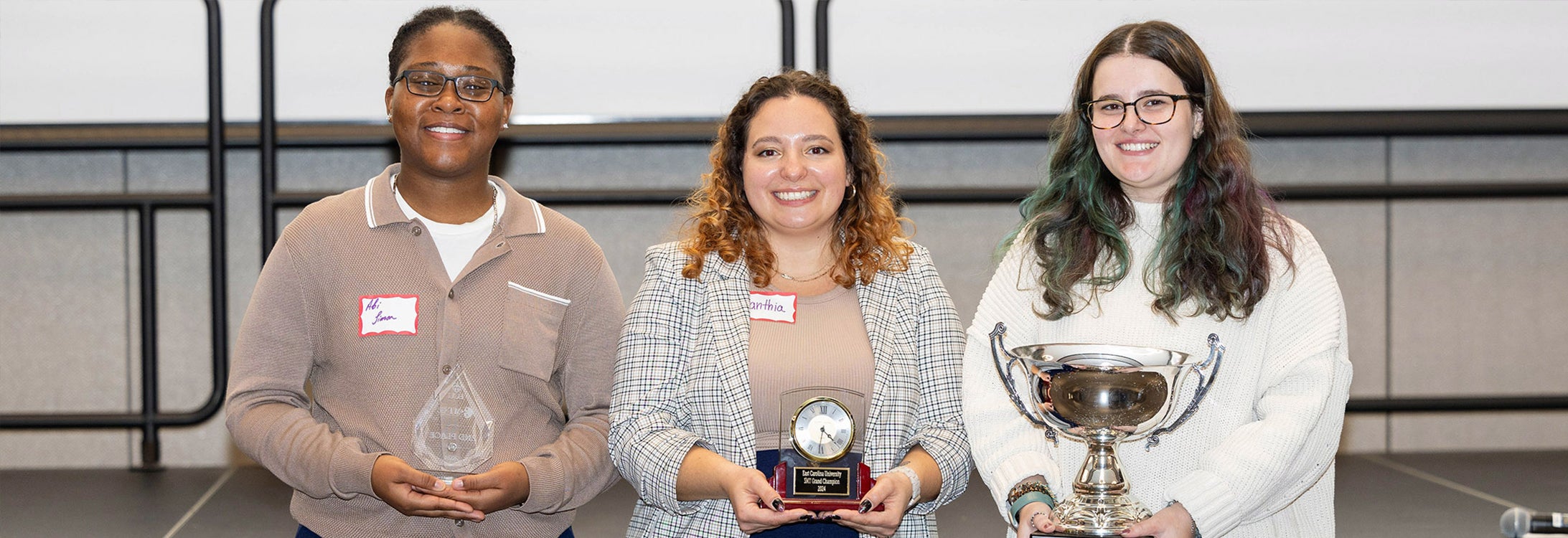Shifting the attitude of reporting sports-related head injuries
Xanthia Saganis, an East Carolina University doctoral student in the Thomas Harriot College of Arts and Sciences health psychology program pursuing a concentration in clinical health, is studying athletic injuries. Specifically, she is interested in sports-related traumatic brain injuries (TBI) and the factors that affect an athlete’s reluctance to or acceptance of reporting head injuries and concussion symptoms.
In November, she was selected as the winner at ECU’s annual Three-Minute Thesis (3MT) competition hosted by the Graduate School, where she described her research proposal. Saganis goes on to compete in the regional 3MT competition at the Southern Council of Graduate Schools annual conference in Dallas, Texas, in March.
“I’m stunned,” she said. “Learning how to talk about your research in a way people will understand and care about it is important. That’s why I wanted to jump on that opportunity. I looked at it as a good experience, not as a competition. So it’s really exciting.”
Originally from Pittsburgh, Pennsylvania, she said she chose ECU because of the clinical and research training experience she could participate in and because of her unique focus on neuropsychology, one of the most competitive specialties to get into that is available at ECU. She was fortunate to be accepted to work under the direction of Dr. Erik Everhart, a professor in the Department of Psychology who is board certified in clinical neuropsychology and mentors one student per year.
“I like that he allows his mentees the flexibility to branch out, follow their passion and study what they want,” Saganis said. “He fosters what we want to do and teaches us about the realities of the field and what it will be like.”
“The energy in her presentation blew me away,” Everhart said of Saganis’ 3MT presentation. “I was captivated.”
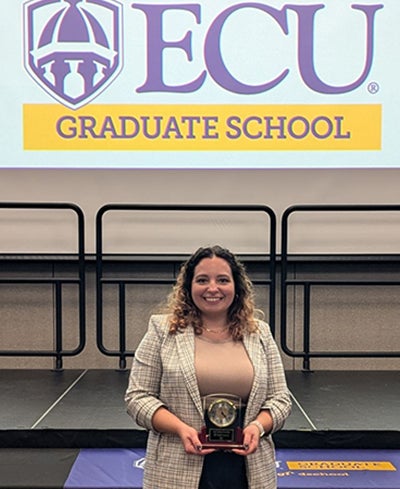
Saganis holds her winning trophy from the Three-Minute Thesis competition. (Contributed photo)
Everhart teaches and trains doctoral students to evaluate and manage patients who have had TBIs. During his post-doctoral training, he assisted in pre- and post-concussion testing on players in the National Hockey League and National Football League. Since then, he and his students have been performing research on caregivers and TBI and to what extent people report having a brain injury. He said there is a lack of awareness of what constitutes an injury and concussions. In one study, he indicated that 25% of people reported they had an injury or concussion, but when given all the symptoms, that number went up to 75%.
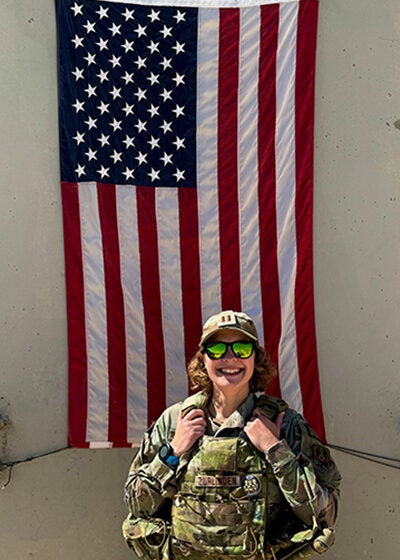
Dr. Taylor Zurlinden, a captain in the United States Air Force and ECU alumna, spent her time at ECU studying people’s understanding of TBIs. (Contributed photo)
Having an increased knowledge of concussion symptoms is important, Everhart said, especially for many schools and universities in North Carolina where there is mandatory baseline testing. This gives coaches and other staff something to compare to when an athlete gets injured. He said there has been a stigma about reporting injuries in the past.
“Athletes struggle to report for a variety of reasons. They don’t want to be removed from the game or lose a starting position,” he said. “We’ve had people try to purposely lower their baseline scores so that if they do get a concussion, we can’t tell. Some prominent athletes have said they purposely tanked their scores, but now we have better things built in to detect that.”
He said the NHL and NFL now have people who watch for signs of brain injury and concussion, but this is not necessarily the case in other sports.
The overarching theme within Saganis’ research springboards off research performed by Everhart and former student Dr. Taylor Zurlinden (MA ’19, Ph.D. ’22), who spent her time at ECU focusing on people’s understanding of TBIs.
“I came up with the idea after working in various clinics across ECU,” said Zurlinden, now a captain in the U.S. Air Force and a clinical psychologist at Mountain Home Air Force Base in Idaho. “I noticed that individuals’ beliefs about TBIs greatly impacted their lives and their predictions for their future well-being. I also noticed that healthcare providers sometimes fell into the trap of TBI misinformation, which could have adverse impacts on recovery and outcomes.”
Zurlinden said misinformation includes the myth that it is dangerous to sleep after a TBI or that a person needs to stay in a dark, quiet room for days following an injury.
“While it is possible — although very rare — for someone to die in their sleep after a TBI due to complications, it is actually vital for someone with a TBI to get sufficient sleep as this is one of the most important things for recovery,” she said. “And, not doing anything and avoiding stimulation will make the recovery process more challenging and folks are likely to have prolonged sensitivity as a result.”
As a lifelong sports fan and a hockey player, Saganis said she became interested in learning more about head injuries from her experiences, knowing others who play hockey, and watching the movie “Concussion,” staring Will Smith as a forensic pathologist who fights against the NFL trying to suppress his research on chronic traumatic encephalopathy brain degeneration suffered by professional football players.
“That history has always been fascinating to me,” she said. “Concussions can be more difficult to identify. It is a hidden injury caused by rapid movement of the brain within the skull.”
In her presentation, Saganis said 1.6 to 3.8 million sports-related concussions are reported each year in the United States, but this number is underestimated and about half of concussions go unreported.
Saganis said she thinks many people tend to shrug off head injuries and that there is a disconnect between having the information and a person using that knowledge to make decisions about their health care.
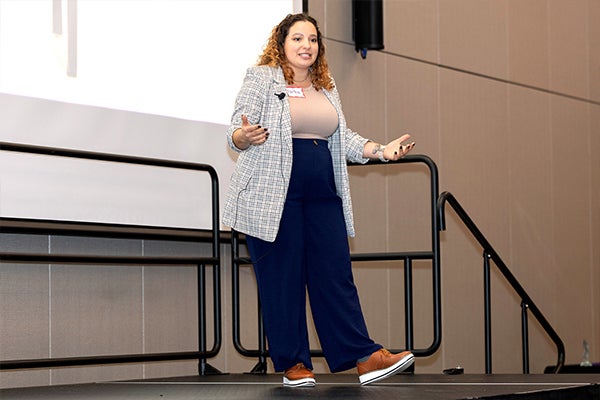
Doctoral student Xanthia Saganis presents during the Three-Minute Thesis competition at the Main Campus Student Center. (Photo by Rhett Butler)
Seeing firsthand that athletes are unconcerned about head injuries intrigued her, and she wanted to learn about the culture. Saganis will be looking at athletes’ knowledge of brain injuries as well as their attitudes and other variables that may predict whether they are more likely to report a concussion.
What she has observed and is hypothesizing is that knowledge alone is not enough. She believes that attitude and beliefs about how serious an injury event is, personality traits, as well as the culture of letting other teammates down, play a role in their decisions.
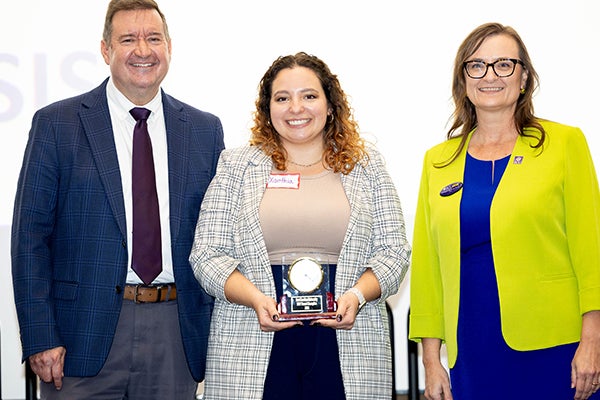
Doctoral student Xanthia Saganis, middle, was declared the winner of ECU’s Three-Minute Thesis competition at the Main Campus Student Center in November.
(Photo by Rhett Butler)
“I’m hoping to learn about attitudes and beliefs about concussions so that interventions can be targeted toward the psycho-social, cultural aspect that is driving current health behaviors and decision-making,” she said.
“While the tough love attitude is a part of sports culture, it becomes dangerous when it masks brain injuries,” she said. “Longtime risks are substantial. Repeated concussions over time can lead to a higher risk for neurodegenerative diseases such as Alzheimer’s.”
Saganis is optimistic that her research will help others in the future.
“I am hoping this will become a body of research focusing on the psychological factors of health care decision-making,” she said. “I aim to help shift the sports culture to better respect the severe long-term outcomes of concussion. Because, in the end, why risk it?”
As part of the clinical health practicum, Saganis is gaining real-world experience working in ECU’s Psychological Assessment and Specialty Services Clinic. This nonprofit training clinic provides patients with professional, confidential psychological services. Saganis is performing psychotherapy and Attention-Deficit/Hyperactivity Disorder assessments. Next year, she will work more closely with Everhart in his clinic.
Upon completing her degree, Saganis hopes to become a board-certified clinical neuropsychologist. She said she would love to continue her research on TBI and sports-related concussions and that she also has an interest in working with older adults who have dementia, as well as former athletes who have a long history of concussions.
